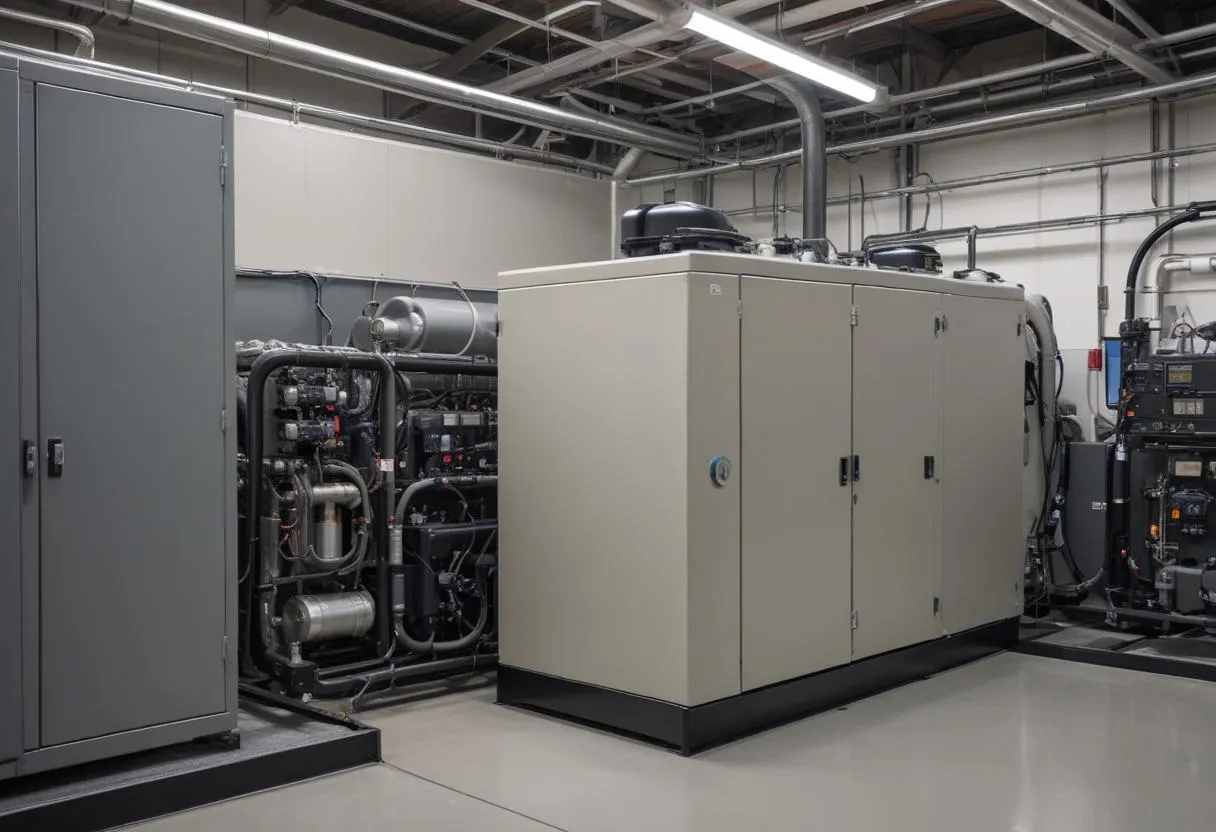 Pump noise in industrial settings often originates from a variety of sources. Understanding these sources is crucial for effective management and reduction strategies. The following are some of the most common culprits:
Pump noise in industrial settings often originates from a variety of sources. Understanding these sources is crucial for effective management and reduction strategies. The following are some of the most common culprits:
Vibration: Mechanical vibrations are primarily caused by imbalances in the rotating parts of the pump or misalignment of the pump and motor. These vibrations can travel through structures and cause noise.
Hydraulic Forces: Turbulence and cavitation within the pump’s flow can also contribute significantly to noise levels. Cavitation occurs when pump inlet pressure drops below the liquid vapor pressure, forming vapor bubbles that collapse violently upon entering higher pressure zones. This not only creates noise but can also damage the pump.
Gear and Bearing Conditions: Worn or improperly lubricated gears and bearings can contribute to the overall noise by creating grinding or squeaking sounds. Regular maintenance is crucial to prevent this issue.
Aerodynamic Noise: This form of noise arises when air is pushed through small gaps, such as the clearance between the impeller and the pump casing. The air flow can become turbulent, leading to increased noise levels.
Motor Noise: The electric motors themselves can be sources of noise, especially if there are issues with electrical harmonics or unstable mechanical components.
To organize these sources effectively for analysis or reporting, a table can be quite helpful:
| Noise Source | Description | Common Remedies |
|---|---|---|
| Vibration | Imbalances or misalignments in rotating parts | Rebalancing, proper alignment |
| Hydraulic Forces | Turbulence and cavitation within fluid flow | Optimize flow, avoid sharp bends |
| Gear and Bearing | Wear and inadequate lubrication | Regular maintenance, proper lubrication |
| Aerodynamic | Air flow caused by tight clearances | Increase clearance, redesign impeller/casing |
| Motor Noise | Electrical and mechanical instabilities | Inspect and repair motor, harmonics analysis |
By identifying these common sources and understanding their mechanisms, steps can be taken to reduce the impact of noise in pump applications. Each source requires specific approaches tailored to the nature of the produced noise and the type of pump system in use. Regular maintenance and periodic reviews of pump systems are recommended to identify potential issues early and apply corrective measures effectively.
Techniques for effective noise reduction
To effectively reduce noise in pump operations, several techniques can be employed. These methods not only improve the working environment but also enhance the longevity and efficiency of the pump systems.
- Soundproofing Enclosures: Installing soundproofing enclosures around pumps is a direct method to contain and minimize noise. These enclosures are designed to absorb sound, preventing it from dispersing into the surrounding environment. Materials commonly used include mass-loaded vinyl, acoustic foam, and fiberglass.
- Anti-vibration Mounts: Using anti-vibration mounts and pads can significantly reduce the transmission of vibrations from the pump to the surrounding structures. These devices are made from materials like rubber or polyurethane, which absorb vibrations and reduce the resultant noise.
- Isolation and Damping Techniques: Isolating the pump from the rest of the installation can prevent noise from being carried through the piping. Damping materials may be applied to pipes and equipment to absorb vibrational energy.
- Use of Flexible Couplings: Flexible couplings can accommodate misalignments and reduce the transfer of vibration from the motor to the pump, thereby decreasing noise output.
- Optimal Pump and System Design: Designing the system to operate away from resonance frequencies and ensuring it is optimally tuned are critical. This involves selecting the right pump size and type for the application to minimize turbulent flow and cavitation.
Also, sound attenuation techniques can be systematically summarized in the following table:
| Technique | Description | Implementation |
|---|---|---|
| Soundproofing Enclosures | Enclosures that absorb or block sound. | Install around noisy pump systems. |
| Anti-vibration Mounts | Materials that absorb vibrations. | Place under pumps and machinery. |
| Isolation and Damping | Prevent vibration transfer to structures. | Apply to connective pipes and structures. |
| Flexible Couplings | Accommodate misalignments, reduce vibrations. | Install between motor and pump. |
| Optimized System Design | Design systems to avoid resonance and excessive noise. | Consider during the initial system design phase. |
Implementing these techniques requires thorough analysis and understanding of both the noise sources and the operational dynamics of the pump system. Collaboration with engineers specializing in acoustics can be particularly beneficial to tailor solutions that are both effective and economically feasible. Regular monitoring and maintenance also play a crucial role in sustaining the noise reduction effects over the long term. By adopting a proactive approach towards noise management, industrial facilities can significantly mitigate the adverse effects associated with pump-generated noise.
Case studies on successful noise minimization
 In the pursuit of practical solutions for noise reduction in industrial pump applications, several companies have conducted case studies to demonstrate successful strategies. Here are three distinct approaches:
In the pursuit of practical solutions for noise reduction in industrial pump applications, several companies have conducted case studies to demonstrate successful strategies. Here are three distinct approaches:
1. Automotive Manufacturing Plant:
A large automotive manufacturer faced significant noise issues from their coolant pumps, affecting plant worker comfort and productivity. By incorporating soundproofing enclosures and anti-vibration mounts, they were able to reduce noise levels by 30%. The company documented the process, which involved:
- Initial noise level measurement to identify key problems areas.
- Installation of custom-designed acoustic enclosures made from mass-loaded vinyl.
- Use of heavy-duty anti-vibration mounts under all high-impact pumps.
- Follow-up noise level measurement to assess the effectiveness of the interventions.
2. Chemical Processing Facility:
At a facility dealing with aggressive chemical reagents, pumps were generating excessive noise due to both mechanical and hydraulic issues. The facility opted for a system redesign that included the installation of flexible couplings and a refinement of their hydraulic design to minimize cavitation. Success was evident in a 40% noise reduction and an unexpected increase in pump efficiency. A bullet point summary of their approach includes:
- Evaluation of existing pump designs and identification of cavitation causes.
- Designing and implementing flexible couplings between pumps and motors.
- Optimizing the hydraulic flow paths to reduce turbulence and cavitation.
- Continual monitoring for adjustment and maintenance.
3. Water Treatment Plant:
A water treatment plant achieved remarkable noise reduction by focusing on pipe isolation and system layout optimization. By reorganizing the layout to avoid sharp bends and using damping materials on the pipes, they managed a 25% reduction in noise levels. Here’s an overview of their strategy:
| Step | Action | Result |
|---|---|---|
| 1 | Detailed assessment of existing pipe layout and noise sources. | Identification of critical noise points and operational inefficiencies. |
| 2 | Redesign of the pipeline to eliminate sharp bends. | Reduction in turbulence and associated noise. |
| 3 | Installation of damping materials along key contact points. | Further noise abatement through vibration absorption. |
These case studies underline the importance of tailored, site-specific solutions in noise reduction for industrial pump applications. Each scenario presents unique challenges and requires a bespoke approach to mitigate noise while maintaining or even enhancing operational performance. Thorough analysis and systematic application of proven noise reduction techniques, as demonstrated by these case studies, exemplify effective strategies that can be adopted industry-wide for improved worker safety and environmental compliance.